|
Golden Ears, “Swissies” and Strange Detours, but Last Man Standing:
A History of Thorens
by Keith Wright
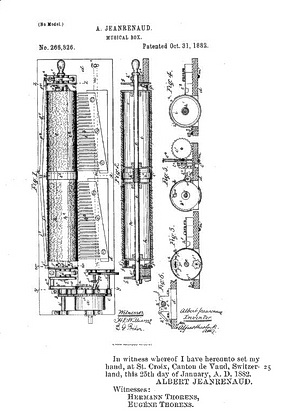
|
|
Paillard 1882 patent drawing, with superimposed witness section from same patent, showing name of Hermann Thorens who would start the company we know today.
|
|
|
An acquaintance once told me that, if you have two of anything, you then have a collection and if you are of the collecting mind you can’t help but expand that collection. This was told to me as said
acquaintance attempted to avoid further clutter by giving me the second antique record brush he had accumulated. Apropos of nothing at all, I now have three. Unfortunately, his sage words had not
been passed to me before I was surprised to find—and of course buy—a portable spring-wound machine from what I thought was a modern high-end turntable manufacturer. Thorens, as it turns out,
as worded by someone who listened to my talk on the subject, “…was right there at the beginning, weren’t they?” Absolutely.
Many gents of a certain age—and yes, they were almost all gents—went through a development phase where they suddenly grew a pair of “golden ears”. Clutching their vinyl records, they would sneak
up on their record-playing equipment, to prevent stirring up any pop-causing dust, and place them on strictly-approved turntables that didn’t use “ten-pound tone arms and rusty nails” for playback (read:
only the latest cartridges at a tracking force that barely tickled the vinyl). The list of approved turntables included such names as Rega, Linn and the erstwhile Swiss manufacturer Thorens, who supplied
my personal golden-ear solution. It would be a surprise to my former self that I became very interested in record playing machines which truly did use “ten-pound tone arms and rusty nails”. OK, new
needles for wind-up gramophones aren’t really rusty but they sure look like headless nails.
1883-1985 Music Boxes
According to the Museum of Music Boxes and Automatons in Sainte-Croix, Switzerland, when the clockmaker Antoine Favre-Salomon, a native of Geneva, invented a musical pocket-watch in 1796, he
became the “Inventor of the music box”. The museum also notes that “Sainte-Croix became the world capital of mechanical music”. The earliest artifact I have found regarding Thorens is a patent
dated 1882 to the Sainte-Croix music box manufacturer, Paillard, which was witnessed by Hermann and Eugéne Thorens. Paillard and Thorens would be intertwined for years, probably because Eugéne
is reputed to have been brother-in-law to Ernst Paillard, Manager of the Sainte-Croix Paillard works. In 1883 Hermann Thorens (1856-1943), Eugéne’s brother, would himself register a company and begin
producing music boxes and parts out of Sainte-Croix. This latter is the company we know as “Thorens”.
Below is a quick overall list of the music boxes I have seen with Thorens movements. As noted above, Thorens produced whole music boxes as well as parts for third parties. I publish this with some
caution as every time I turn around there seems to be another Thorens music box (maybe a 20 cm “Helvetia”?).
- Thorens-made metallic disc players with: interchangeable 4.5" metallic discs and a 30-tooth comb called an AD30 (AD = Automatic Disc?); and another with 11" (28cm) interchangeable discs, called
"Edelweiss" or AD41 (with 41-tooth comb?). The rights to the AD30 players were bought by music box manufacturer Reuge, in 1985/86.
- Cylinder music box movements in Thorens boxes or used by third parties comprising:
6 songs, 41 notes ,"#32"; 4 songs, "#30";
6 songs, "AL636"; 4 songs, 52 notes "AL 450"; 3 songs, "AL350"; 3 songs, "AL336";
3 songs, "No. 308"; 2 songs, "A228"; 2 songs, "AL236"; 2 songs, "AL241"; and 1 song, "A128".
- Wooden, revolving music figures made by the Italian firm of Anri, using single-song Thorens music box movements.
- Particularly ornate music boxes commissioned and imported from India by Fred Zimbalist (a relative of violin virtuoso Efrem Zimblast).
- German toy brand "Schuco" produced at least two toy cars containing Thorens music box movements, one in 1938 ("Radio 5000") and the other from 1952 to 1964 ("Radio 4012").
The music box stood in as the car's radio, hence 'Radio' was part of the model name.
In 1985/86 Reuge SA, a music box manufacturer which in 1865 started as a musical pocket-watch shop in Sainte-Croix(!), took over production of Thorens AD-30 disc music boxes.
1902-1940 Acoustic Phonographs and Gramophones
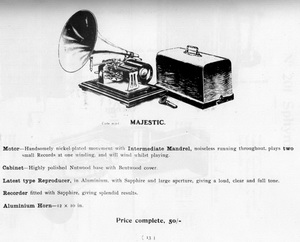
|
|
Thorens 1907 catalog showing typical harp-shaped sides and aluminium construction on a cylinder player.
(Reprinted by City of London Phonograph and Gramophone Society in 1967
--collection of Keith Wright)
|
|
|
It’s generally cited that in 1903 Thorens began making cylinder phonographs. There is, however, a Thorens publication which implies that the first cylinder machines were made in 1889
and then explicitly states that they were first offered in their 1902 catalog. These machines were essentially, at least initially, variations of the American models of the time, with harp-shaped
sides and aluminium construction. It is the harp-shaped sides that has led me to identify as a Thorens, a machine labelled as a Sylvia “C”. My posting led to German collector Manfred Unger
(who has a great website at Phonographen.com) contacting me to say that must mean his Sylvia “B” is also a Thorens. On firmer ground, there is a machine in Jean-Paul
Agnard’s collection, identified as a Thorens “Cleopatra”, curiously made for right or left-handed owners (shown here: The Cleopatra).
Courtesy of Brian Oakley of the City of London Phonograph and Gramophone Society, I have copies of portions of three Thorens catalogs--1907, 1910 (although the machines seem more primitive
than the 1907s) and 1914—which the Society bundled into one volume in 1967. The catalogs were originally loaned by Thorens (‘Monsieur Thorens’) to the Society’s secretary at the time, Ernest Bayly.
In the 1907 catalog, Thorens list the Columbia Eagle look-alikes, Royal, Majestic and Minerva plus a machine very much like a Columbia ‘AT’ called the “Capital”. The 1910 catalog lists 5 cylinder players
simply labeled “No. 1” to “No. 5”. The 1914 catalog does not list any cylinder players at all.

|
|
Ornate outside-horn Thorens machine from 1914 catalog.
(Reprinted by City of London Phonograph and Gramophone Society
in 1967
--collection of Keith Wright)
|
|
|
As an aside, in the collection of Patrick De Caluwé, of Belgium, is a Thorens Hexaphone that, “holds six cylinders which are reproduced in succession after the introduction of a coin” (which can be seen
here: Thorens "Hexaphone").
In 1906, Thorens started producing outside-horn disc gramophones (sources say “changed to” but cylinder and disc machines were offered side-by-side for at least 8 years). Other companies did the
same with less expertise in spring-driven mechanisms, such as furniture companies, piano companies, aircraft companies (!) and organ manufacturers.
As longtime British collector Howard Hope puts it, “Broadly there are two recognised qualities of horned machine. Those made by the ‘Big Three’ manufacturers (HMV, Columbia and Pathe) and the
other smaller makers whose products often make up in charm and colour what they lack in playing ability and finesse of finish. These lesser machines are often affectionately referred to as ‘Swissies’
in recognition of their (often) German-Swiss origins.” There is no doubt that the European colour esthetic —especially in the eyes of North American collectors— is quite different. I for one can appreciate these pretty machines.
While these early Thorens products may lack respect from British collectors today, there is compelling evidence that their volumes were a force to be reckoned with. In his article “The failed 1912
merger between Carl Lindström AG, the Gramophone Company Ltd and the Victor Talking Machine Co Inc.”, Peter Martland noted the following: “In 1911, the Swiss manufacturer Thorens exported
clockwork motors for use in British-made disk players to the value of £75,000 [M1,875,000 or $375,000]. In comparison, the machine turnover of the British branch of the Gramophone Company
was £108,242 [M2,706,050 or $541,210]...the extent of German and Swiss domination of the British and Russian record player trade must have been phenomenal.” In short, in one single market,
the value of just the motors that Thorens sold to the local industry equaled 75% of the total revenue collected selling the complete machines—motor, case, tone arm, etc.— sold by the largest local company. Clearly they were successful.
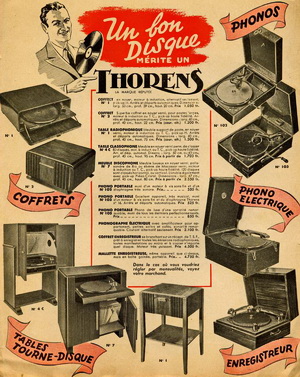
|
|
Thorens flyer from 1939 showing electrical and spring-driven machines.
(Collection of Keith Wright)
|
|
|
As described by the Swiss site Radio Phono Mania [and clumsily translated by KW]: “In the 16 industrial buildings which were built over the years, the internal combustion engine, which in 1883
generously developed 7 HP, gave way to the electric generator supplying the 2000 kW needed to spread around the world some 2 to 3 million components and complete phonographs. By 1928/30 Thorens had some 1200 employees.
“[They had] commercial representatives in New York , London, Paris, Brussels, Milan, Frankfurt, Nuremberg, Amsterdam, Copenhagen, Oslo, Stockholm, Helsinki, Lisbon, Madrid, Athens, Alger [Algiers?],
Antananarivo, Johannesburg, Sao Paulo, Buenos Aires, Caracas, Mexico [and] Sydney.
“Foreign brands bought complete machines or components from Thorens. Perophone was the trademark of Vermon Lockwood Manufacturing Company of London which since the 1910s successfully
distributed Columbia gramophones. In the early 20s, the portable Pixie Grippa had mechanics that came from Thorens. Perophone distributed, under its own name, boxes of needles always represented
by a race dog race with a disc in its mouth.”
On my website there are photos of a Columbia 122 portable with Thorens motor and turntable. This clearly isn’t a retro-fit. Also there is a ‘Kompact’ cameraphone with a Thorens motor as well
as pictures of a ‘Pal Jr.’ portable with a Thorens motor.
The previously-mentioned 1914 Thorens full catalog shows a bewildering 33 inside-horn table-top gramophones, 18 outside-horn machines and four uprights. A 1936 catalog which I was fortunate to
find lists “tone-arms, sound boxes and accessories for talking machines”. Among the many parts listed can still be found back-brackets and elbows for outside-horn machines.
As noted above, Thorens did have commercial representation in New York by 1928/30 but I have found few acoustic machines—save a notable exception which I will mention below. I own one of
the two table-top gramophones that I’ve seen and one CAPS member has two outside-horn machines (which I believe were not acquired in North America).
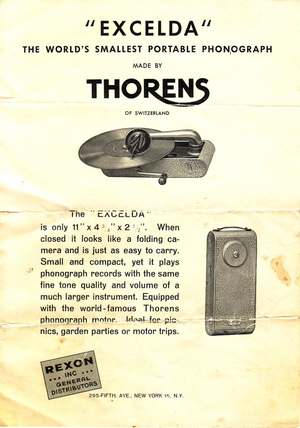
|
|
Thorens instructions for their popular cameraphone. Judging by reproducer, date is 1942-47.
(Collection of Keith Wright)
|
|
|
What Thorens was able to ship to North America in numbers were portables. A few versions reminiscent of the HMV portables (or the 1924 Victor VV 35, the first suitcase portable after the VV 50)
are readily available. But the most notable portable incursion into North America was the “Excelda”. These were available in black wood, with mica diaphragms, starting in 1935 and in various colours
(black, brown, green, red, blue and grey) with metal bodies and diaphragms from 1942 to 1947. They are reminiscent of Kodak ‘autographic’ or ‘No. 1’ bellows cameras of the time (on my website,
I compare one to a Toronto-made No. 1A Pocket Folding camera series II, 1929-31, originally $24.50). I also list various adverts that call the Excleda “The World’s Smallest Portable Phonograph”.
Truth in advertising clearly hasn’t changed much.
On my website, I also show pictures of what clearly are Thorens Exceldas with the embossed title on the leather handle changed to “Phonopoche” (pocket phonograph?) for a French-speaking market
and “Colibri” (“Hummingbird”) for a well-known Belgian firm, which commonly used Swiss parts in ultra-portables. I also show what must be a Soviet knock-off marked from the “Moscow Pathéphonic Factory”.
The latter definitely does not look like it rolled off the same assembly-line.
What I haven’t seen in North America is the cute, wooden ‘suitcase’ portable called a Graphonette that was apparently available in walnut, mahogany, imitation leather and leather.
Clearly, since the Exceldas are from 1947, they were amongst the last of the Thorens original acoustic gramophones. However, the wind-up business likely extended into the LP era presumably to
supply electricity-free markets still using wind-up 78 RPM players—and I have evidence that the leftover inventory has haunted us as late as 2005. I have pictures of a ‘new-old-stock’ Thorens
‘pillar-and-plate’ motor from a recently-opened ‘old stock’ box with the motor wrapped in a newspaper dated April, 1960. Similar old stock is no doubt the source of the Thorens motors that can be
found in some modern fake gramophones (the notorious “crapophones”) – these are not the ones that have the winding-handle suspiciously jutting out at the unnecessary high angle of an English suitcase portable.
1913-1964 Diversions
During its history, Thorens ventured into the production of three products that seem odd given the company’s generally-accepted expertise.
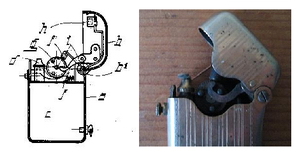
|
|
Detail of drawing from Thorens 1919 patent with lighter from
KW collection. If lighters were just to publicize the Thorens name,
they put a lot of work into them.
|
|
|
According to a 2008 Thorens publication, “What is far less known, however, is that between 1913 and 1964 Thorens also manufactured more than 5 million pocket lighters to help
establish the Thorens identity worldwide”. If that truly was their goal, and not to actually enter that business, I have a number of questions. Why didn’t they outsource production
and just have another manufacturer affix the Thorens label?
Why did they make them so good? According to one source, “[Thorens, 1920s to 1960s] Swiss made of the highest quality. They are almost in the class of Dunhills… Their most
sought after lighter models are of the 1920s to 1930s era. The company moved into making record turntables, speakers, and other music items[!]. Their ‘Standard Original’ model
was introduced in 1919 and was successful enough to convince the company to continue to manufacture lighters”. (“The Golden Age of Cigarette Lighters”, Ira Pilossof & Stuart
Schneider, 2004 Schiffer Publishing Ltd)
Why did they put so much R&D into lighters? I have seen a series of patents attributed to Thorens for lighters dating from 1919 to 1940. There are likely more.

|
|
Thorens 1949 publication showing a Canadian connection.
(Courtesy Manfred Wewers)
|
|
|
From 1914-1921 and from 1938-1952 Thorens made harmonicas—Tremolos, octave harps, 10-hole Richter diatonics, 10-hole and 12-hole slide chromatics, and four-key tremolo harps.
Thorens apparently also made the Gretsch (guitar and drum firm) Chromatic #235 harmonica. And Walt Cunningham (2012 personal correspondence) sent me, “ Did you know that
Thorens manufactured plastic 10-hole harmonicas during WWII? I owned and played them during the time when The ‘Unpleasantness’ precluded import of [German] Hohner harmonicas.
I was but 9-years-old at the time, but the memory of Thorens plastic instruments is treasured”. There is also a Canadian connection in that the Canadian harmonica virtuoso, Bernie Bray,
endorsed Thorens harmonicas in Toronto in the late 40s. A Thorens flyer printed in Switzerland in 1949, which includes beginner’s instructions, was titled, “It’s Easy To Play The Bernie Bray Way”.
Most curiously, from 1954 to 1960, Thorens made mechanical razors. Collector Paul Linnell describes it as: “1952, Thorens Riviera, Switzerland. Effective, non-electric razor. Amorphous two-part
body in cream urea plastic, designed to fit into the hand. Powerful wind-up spring via large built-in key on back, gives generous shaving time. Rotary cutter and foil head. Push toggle switch, red
logo (some versions also in black). Red PVC zip-up pouch. Registered design number 876,564, patent application number 30106/52 (1952) patent number 748,126 (1956)”. Were they trying to
find some other purposes for their spring-driven expertise? “Design for Environmental Sustainability” by Carlo Vezzoli, Ezio Manzini, Springer (2008), lists the Thorens Riviera and mentions that,
“Winding up 8 times provided 3 minutes of working time”. Finally, at one time Heather Mills had a website highlighting good design and had a page on the Thorens Riviera… of material pirated from my website.
1928 - Present Consumer Electronics
In 1928 Thorens sources say they developed an electric motor for gramophones and continued on in this business. This motor has also been called the first electric ‘direct drive’ turntable. There is some
dispute, however, as the patent generally cited (CH 140160) is owned by Paillard (who was also producing gramophones) and all Thorens patents of this time seem to be acoustic gramophones.
Thorens continued on expanding their consumer electronics business. I have a brochure ostensibly from 1939 showing two suit-case wind-up portables, and listing what might be a third (no Excelda), plus
a gaggle of electric consoles, “phono-electric” portables and radio-phonographs. There is also a 1944 patent owned by Thorens on an automatic record changer and one in 1945 for a “wireless receiver”,
the drawing for which, if turned upside down, looks identical to the “New Century tuner 1949-1952” listed by the online “Radio Museum”. I also have a Thorens brochure from 1953-56 showing all-electric
turntables, record players, loud speakers and more.
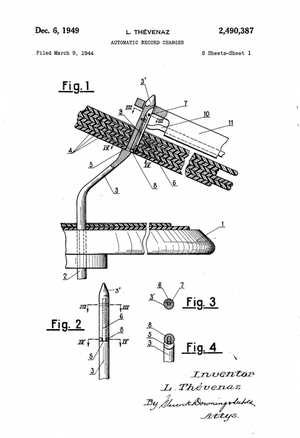
|
|
Shown is a diagram from a 1944 record-changer patent by Thorens. Ten years later the designer, Louis Thévenaz, would also be responsible
for arguably Thorens most famous product.
|
|
|
In 1956, Thorens produced a turntable that would cement its reputation as a high-end consumer ‘audiophile’ company. In “Swiss Precision: The Story of the Thorens TD 124 and Other Classic Turntables“,
by Joachim Bung (published by Joachim and Angelika Bung) summarized by Art Dudley in Stereophile (April 30, 2008): “In 1956, an engineer named Louis Thévenaz presented his employer with the prototype
of a turntable of singularly high quality, aimed at broadcast professionals and the burgeoning domestic audio market alike. The employer was Thorens S.A. of Sainte-Croix, and one year later, the first TD 124
(a tourne-disc, or turntable, with a 12” platter and four speeds) was introduced for the then-remarkable sum of 400 Swiss Francs. With its 10W motor, 10-lb lower platter, clutch-decoupled upper platter,
combination drive system of belt and idler wheel, and sculpted good looks, the 22-lb Thorens TD 124 took the audio world by storm. After the Garrard 301 of 1953, the TD 124 was the player to which
most European and American hobbyists aspired, and by the time production ceased in 1967, Thorens had made more than 90,000 of them.” By my calculations, 400 Swiss Francs equaled $91.40 in 1956,
which becomes $730 in 2009, based on CPI. It apparently is a good thing that Thorens came out with this new system as the St. Petersburg Times of February 7, 1960 (pg. 37) points out, “Until 1957, Thorens,
one of the leading turntable and changer manufacturers, had a bad rumble problem”.
As they say, “The rest is history” and I will not detail Thorens electronic products much further as the subject is fully covered by great online resources. (Louis Thévenaz was with the company from at least
1944—as his name is on the patent for a record changer that year (See cover.)—into the 1960s, when his name continues to appear on Thorens phonograph and lighter patents.)
Last Man Standing?
In 1963, Thorens merged with Paillard SA, Ste.-Croix (family history?), which at the time was producing calculators, Bolex cameras and Hermes typewriters.
In 1966 Thorens de-merged with Paillard, ‘moved’ to Germany and merged with Wilhem Franz’s company, EMT, forming Thorens-Franz AG. There are sources that suggest this was somehow a cost-cutting
move to compete with the Japanese. The erstwhile Swiss turntables were now being produced in Germany. Thorens would make an issue about this after 2000, touting its triumphant return to Switzerland.
In their own words, “[In 1972] Thorens develops the TD 160 and writes history”. This would be the “Golden Ears” turntable that started me on the road with Thorens.
In 1979 Thorens built the “Reference” model as an experiment to, “ build the best sounding turntable regardless of cost”. Officially, 100 of the 90kg units were built and sold.
(In 2010, one changed hands for a reported $50,000 and another before that for €81,000.) Much of what they learned must have gone into the “Prestige” model released
for the company’s centenary in 1983. That model weighed 55kg and cost 17,800DM, or $11,800.

|
|
Advert from Thorens ‘German period’.
(Ottawa Citizen, December 20, 1984)
|
|
|
By 1995, Thorens continued making turntables and even introduced CD players, but there was trouble ahead. They were at the Consumer Electronics Show (CES) as late as 1999,
but they ran into trouble by December 2000 and were looking for new investors (‘Das Ende’--according to one German source). Being denied bankruptcy protection in Germany,
they were revived by Heinz Rohre, restructured and re-launched in 2002 as Thorens Services Ltd. under new management. So “one of the oldest and most experienced manufacturers
of sound reproduction equipment in Europe” still lives. They continue to make turntables, including a TD 160. “[regarding the Thorens TD 309] Looks can be deceiving. At first glance,
you might think that the TD 309 was designed just as an eye-catcher, but in reality it is easily the most radical and innovative turntable Thorens has produced since the company was
revived around ten years ago by the dynamic Heinz Rohrer. Moderately priced at £1,250” (Hi-fi news, June 2010). They also currently produce the TD 550, which is “One of the most
expensive turntables in the world” at $12,000 (the most expensive is $300,000 and is not a Thorens).
In their own words (which may lose something in translation): “There isn‘t an older company out there in the field of entertainment electronics. Thorens holds every record; yet even today
it‘s constantly introducing new innovations. You‘re as young as your LPs – and LPs are younger than ever. Thanks to perfected craftsmanship, they‘ve even managed to survive the ultimate
enemy, the CD”. This was obviously written without thoughts of digital audio files and streaming.
So given the above history, are they the oldest?
- Pathé Frères Phonograph Co. went bankrupt in 1922 and re-launched only to have the French and British phonograph assets sold to the British Columbia Graphophone Company in 1928
and the American assets merged with the American Recording Corporation in 1929.
- Columbia was out of the hardware business by the time it developed the modern Lp and contracted with Philco to make the new Lp playing attachments. The record label is
currently in the Sony Music Entertainment stable.
- Edison famously left the phonograph business in 1929.
- Victor was purchased by RCA in 1929, which in turn was acquired by GE in 1986, which in 1988 sold the consumer electronics business to Thomson. The famous
His Master's Voice logo is now simply a sticker, managed through RCA Trademark Management S.A., that can be "selectively" licensed to slap on a plethora of "stuff"
(including, at one time, fake Philco Predicta TVs).
A case certainly can be made.
Happy 130th to Thorens, the “oldest consumer electronics manufacturer in the world”!
References
- "Music boxes: the collector's guide to selecting, restoring, and enjoying new and vintage music boxes"--Gilbert Bahl, Courage Books, 1993.
- "Music Boxes: a guide for collectors"--David Tallis, Stein and Day, 1971.
- www.thorensad30.com (Site for the smaller disc music boxes)
- Anri (Site for Anri music boxes)
- Mechanical Music Digest (Contains a number of pages on Zimbalist music boxes)
- Mechanical Music Digest (Page regarding the Schuco Radio 5000 mechanical-car music box)
- Mechanical Music Digest (Page regarding the Schuco Radio 4012 mechanical-car music box)
- Thorens History (Text and images saved from a since-removed 2008 free Thorens download.)
- Thorens Catalogue of 1907 (Thorens 1907 catalog, reproduced by City of London Phonograph and Gramophone Society, 1965.)
- Thorens Catalogue of 1910 (Thorens 1910 catalog, reproduced by City of London Phonograph and Gramophone Society, 1965.)
- Thorens Catalogue of 1914 (Thorens 1914 catalog, reproduced by City of London Phonograph and Gramophone Society, 1965.)
- The failed 1912 merger between Carl Lindström AG, the Gramophone Company Ltd and the Victor Talking Machine Co Inc (The failed 1912 merger between Carl Lindström AG, the Gramophone Company Ltd and the Victor Talking Machine Co Inc., by Peter Martland, from the Carl Lindsröm AG
Conference, Budapest, Thursday, 04 December 2008.)
- "The Golden Age of Cigarette Lighters" by Ira Pilossof & Stuart Schneider, Schiffer Publishing Ltd., 2004.
- Thorens Riviera Mechanical Razor (Paul Linnell's mechanical razor page.)
- "Design for Environmental Sustainability" by Carlo Vezzoli, Ezio Manzini, Springer (2008), Pg. 112-113.
- RadioMuseum (The online Radio Museum. Where you will find a number of pictures from my Thorens research amoung its many pages of Thorens models.)
- "Swiss Precision: The Story of the Thorens TD 124 and Other Classic Turntables" by Joachim Bung, published by Joachim and Angelika Bung, 2008.
This article is an organized distillation of the ever-growing ‘shaggy dog’ of Thorens history kept at:
The History of Thorens Through My "Collection"
|